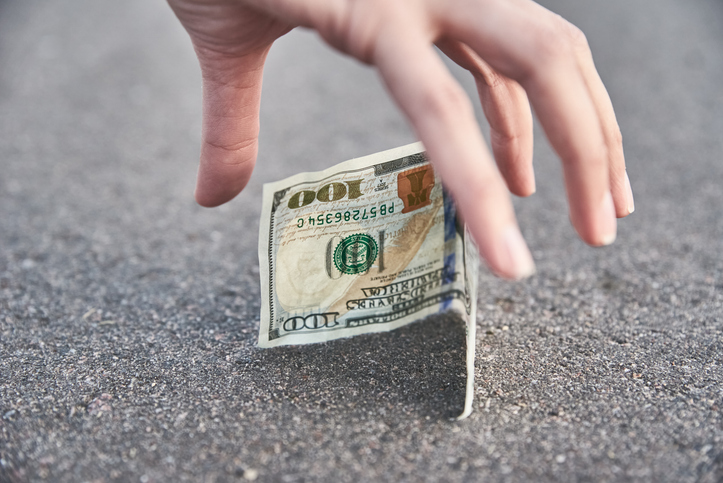A Portfolio That Can Weather Any Storm
The most obvious bubble in the market got hammered earlier this week...
Tech stocks – like market darling Nvidia (NVDA) – collapsed when Chinese company DeepSeek unveiled its artificial-intelligence ("AI") tool. DeepSeek claims its AI matches the major players for a fraction of the cost.
Investors panicked on the news, and Nvidia lost nearly $600 billion in market value in one day.
We've warned of a correction in overhyped tech stocks for months. During times like these, it's good to remember our basic principle: Always keep your portfolio sound. Just as you would properly secure your valuables in preparation of a hurricane, make sure your investments can weather any storm.
No matter what happens with this market, I know a lot of folks feel the pressure. Stress runs high. Maybe your emotions take over.
Don't let that happen.
So if you want to keep your portfolio safe, here are two steps you should take today...
Step 1: Have a plan.
You can keep the inevitable losing trades from wrecking your portfolio with two simple (and easy) methods: Use stop losses and follow proper position-sizing advice.
My team and I regularly recommend using 20% or 25% stops. These take the emotion out of investing and keep you from staying on a sinking ship. So choose your stops and stick to them.
Similarly, we practice "position sizing" by recommending that you never put more than 4% to 5% of your portfolio in any one investment recommendation (like a single stock or bond).
The combined strategies of stops and smart position sizing ensure you never lose more than about 1% of your portfolio on any one investment.
Step 2: Spread out your wealth.
I've written many times about the benefits of asset allocation. Distribute your portfolio among different asset classes – stocks, fixed income, cash, and chaos hedges (like precious metals). Keeping your wealth stored in a diversified mix of investable assets is the key to avoiding catastrophic losses.
You also need to consider something called correlation...
Correlation is a statistic that measures the degree to which two stocks, or sectors, move in relation to one another.
Positive correlation means the two assets move in the same direction together. For instance, when the price of fuel increases, so do the prices of airline tickets. Negative correlation means the assets move in opposite directions. For example, if stocks fall, gold tends to rise.
A good way to protect your portfolio is by making sure all your assets aren't positively correlated – and therefore won't drop in tandem should hard times hit. (If you want to see the correlation between securities, try the calculator at InvestSpy.)
Of course, too many folks will ignore all this advice and still load up their portfolio with the "next big thing." I'm sure plenty of people did this when it looked like Nvidia was unstoppable.
The truth is, no matter how compelling a single stock might be, it's never going to be a smart idea to put all of your money into it. That's a crazy risk to take.
Even putting 10% or 20% of your portfolio into any one stock is a huge gamble, because if something goes wrong – like we've seen this week – you'll watch a big chunk of your net worth go up in smoke.
To really grow and compound your money over time, your total portfolio needs to make sense. It needs to be more than the sum of its parts.
The problem is, the entire financial-publishing industry tends to spend way too much time focusing on individual stocks... and nowhere near enough time on overall portfolio construction.
We're an industry obsessed with ingredients, not recipes.
But, earlier this week, I went on camera to explain why that doesn't have to be a problem for you... My team and I have put together one perfectly balanced, fully diversified portfolio built to grow in any market condition imaginable.
And if the track record we've seen so far is anything to go by, you could more than double what your current portfolio is earning.
This is Stansberry Research's most important recommendation – and it involves a big change we're making on February 4 that I'm positive is going to make it even more profitable.
If you haven't seen my announcement yet, click here to get the full details.
Here's to our health, wealth, and a great retirement,
Dr. David Eifrig and the Health & Wealth Bulletin Research Team
February 1, 2025
| Recommended Link: |
 Make This ONE Move by February 4 Whether you're in stocks or cryptos... it has been a tough week for most investors. But there is ONE money move you should consider by February 4 – a simple step that could have a massive impact on your wealth in 2025... and help you sleep soundly at night. See why right here. |  |
|---|
|
Reader question of the week...
Q: I was reviewing my contributions to my retirement plan the other day and discovered my employer offers something call a Roth 401(k), but I don't know what that is. Can you explain the difference, please? – J.R.
A: Thanks for your question, J.R. As a quick refresher, a 401(k) is a type of employer-sponsored retirement plan.
There are several different kinds of 401(k)s, but the two most folks are familiar with are the traditional and the Roth. The basic difference between the two is taxation.
With a traditional 401(k), you don't pay taxes on any money put into it until you withdraw that money in the future. On the other hand, for a Roth 401(k), you pay taxes when you make the contribution, and your future withdrawals are tax-free (assuming you meet all of the distribution requirements).
A major reason to invest with a Roth instead of a traditional is if you believe your earnings (and therefore tax bracket) will continue to grow. So let's say you're just starting out and not making much right now, but you expect your income to grow significantly over the years. Investing through a Roth now means you'll pay fewer taxes on your contributions. And it'll allow the money to – truly – grow tax-free since you won't have to worry about being taxed on your withdrawals.
In short, a Roth 401(k) frontloads your costs and gives you tax advantages down the road. But not all employers offer a Roth option, so if you're interested in one, check first.
Keep sending your questions, comments, and suggestions our way. We read every e-mail... feedback@healthandwealthbulletin.com.
 | Finding a Ben Franklin on the Sidewalk Imagine you're walking down the street and stumble across a $100 bill, what would you do with it? |
|---|
 | Vanquish Pain... With Just a Chair and Time You can thank a bunch of bodily changes working in concert to derail you from the simple act of standing... |
|---|
 | My Highest-Conviction Trade for 2025 I spend a lot of time dissing the sector in this letter, but I do like some technology stocks... |
|---|
 | Soothe Winter's Dry Skin... Like a Sweaty Hippo If you see a bright red hippo out in the wild, don't worry... It isn't bleeding. It's using its natural skin protector... |
|---|
 | Don't Let the Tech Correction Ruin Everything During times of uncertainty, it's good to remember our basic principle: Always keep your portfolio sound... |
|---|